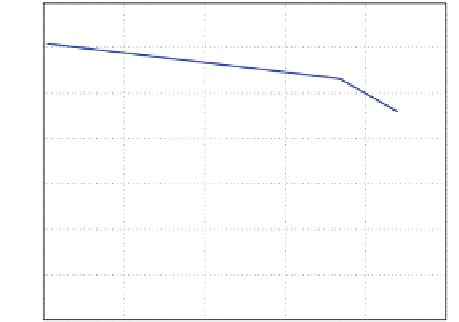Biomedical Engineering Reference
In-Depth Information
Fig. 8
Vo l t a g e (
y-axis
) decay
for different electrode
positions inside the scala
tympany (
x-axis
). 0mm
means that the electrode is
touching the internal wall of
the scala tympani. The
simulation was performed at
nodes 10, 5 and 1
2.6
x 10
−3
node10
node5
node1
2.4
2.2
2
1.8
1.6
1.4
1.2
0
0.5
1
1.5
2
2.5
x 10
−3
[mm]
Additionally, an electrode array positioned close to the modiolus means that the most
apical electrodes will be more deeply inserted covering a larger area of spiral gan-
glion cells. These simulations show that modiolar electrode placement permits the
stimulation of more apical frequency regions (low frequencies). FromFig.
7
, it can be
observed that the extracellular voltage presents a secondary peak with lower ampli-
tude produced by cross turn stimulation. This observation was already presented in
[
17
]. In summary, these simulations show large differences in extracellular voltage
measured at the spiral ganglions for different electrode positions. Additionally, these
differences become larger for more degenerated auditory nerves. The large differ-
ences in extracellular voltage could give some insight in explaining the inter-subject
variability in speech intelligibility observed in cochlear implants users, which cannot
be explained by EFI measures.
3.2 Experiment 2: Simulation of the Voltage Distribution
for Different Stimulation Modes—Monopolar, Bipolar
and Tripolar
The FEMwas also used to simulate different stimulation configurations: monopolar,
bipolar and tripolar stimulation. For monopolar stimulation current was injected
to electrode 11 and the reference electrode was outside the cochlea. For bipolar
stimulation, electrode 10 and 11 were used as active and reference electrodes. For
tripolar stimulation, electrode 11 was used as active electrode and electrodes 10, and
12 were used as the reference. Figure
9
presents the extracellular voltage measured
at nodes 10, 8 and 7 along the spiral ganglion for monopolar, bipolar and tripolar
stimulation (modiolar electrode insertion). Table
4
presents the average spread of






































